HMDT Blog: Staff visit to Poland – visiting Auschwitz
In April 2016, a group of staff members from HMDT went on a learning trip to Poland. Over three days, they visited Kraków and the site of the Kraków Ghetto, Oświęcim and Auschwitz I and Auschwitz-Birkenau concentration camps. This is the second of three blogs written by staff about their experiences on the trip.

Alys
 Why visit Auschwitz? With growing amounts of fiction, non-fiction, television, film, theatre, educational resources and museum exhibitions dedicated to representing and teaching about the Holocaust, what role do the historic sites play in our understanding of this dark period of history? Why do well over a million people visit Auschwitz each year? What led survivor of the Holocaust and Nobel Peace Prize winner, Elie Wiesel to write ‘any one of the fields of ashes in Birkenau carries more weight than all the testimonies about Birkenau’?
Why visit Auschwitz? With growing amounts of fiction, non-fiction, television, film, theatre, educational resources and museum exhibitions dedicated to representing and teaching about the Holocaust, what role do the historic sites play in our understanding of this dark period of history? Why do well over a million people visit Auschwitz each year? What led survivor of the Holocaust and Nobel Peace Prize winner, Elie Wiesel to write ‘any one of the fields of ashes in Birkenau carries more weight than all the testimonies about Birkenau’?
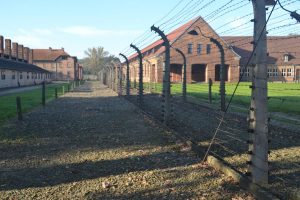 Auschwitz-Birkenau describes itself as a museum as well as a memorial and a key reason for visiting is educational. Most of the blocks that remain in Auschwitz I house exhibitions on the camp and its history. Several of these exhibitions include displays of objects such as suitcases, glasses, shoes and hair that belonged to those killed in the gas chambers. The exhibitions are certainly informative and the exhibits are moving. However, similar objects and displays can be found at museums far removed from Poland, including the United States Holocaust Memorial Museum in Washington and the Holocaust Exhibition at the Imperial War Museum in London. There must be something else about the camp site that gives it its unique value.
Auschwitz-Birkenau describes itself as a museum as well as a memorial and a key reason for visiting is educational. Most of the blocks that remain in Auschwitz I house exhibitions on the camp and its history. Several of these exhibitions include displays of objects such as suitcases, glasses, shoes and hair that belonged to those killed in the gas chambers. The exhibitions are certainly informative and the exhibits are moving. However, similar objects and displays can be found at museums far removed from Poland, including the United States Holocaust Memorial Museum in Washington and the Holocaust Exhibition at the Imperial War Museum in London. There must be something else about the camp site that gives it its unique value.
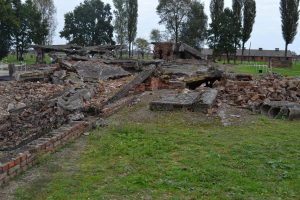 Partly, there is a sense that the real place and the archaeological research conducted in it helps to avoid Holocaust denial. The size of both Auschwitz I and Auschwitz-Birkenau demonstrate the scale of the forced labour and murder that happened inside them. The remains of gas chambers at Birkenau, even in the half-demolished state in which the Nazis left them in 1945, stand as physical proof of the deliberate and industrialised nature of the killing that took place.
Partly, there is a sense that the real place and the archaeological research conducted in it helps to avoid Holocaust denial. The size of both Auschwitz I and Auschwitz-Birkenau demonstrate the scale of the forced labour and murder that happened inside them. The remains of gas chambers at Birkenau, even in the half-demolished state in which the Nazis left them in 1945, stand as physical proof of the deliberate and industrialised nature of the killing that took place.
There is also the power that physical sites have over and above other representations. That is the power of putting the visitor in the place where the history happened. The photographs of Auschwitz-Birkenau may be iconic but they cannot give a sense of the how the camp feels to move around in. You may know the details of how inmates were registered on arrival but it is not until you walk through what the guards called ‘The Central Sauna’, with large windows through which the gas chambers would have been visible to those inside, that the chilling finality of the process becomes apparent. And to walk in to and, perhaps more importantly, out of, the one gas chamber that still exists at Auschwitz I brings into sharp focus the reality that for so many thousands of people this was a room that they were never able to leave.
Of course we must not think that this physical and emotional engagement with the real place allows the visitor to know what it would have been like to be an inmate of Auschwitz. That is as unknowable through this means as through any other.
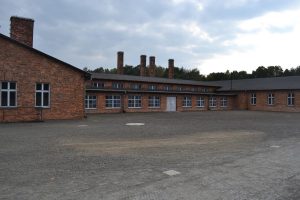 But for me, I felt that visiting the site allowed the time and spatial grounding to reflect on something that we obviously deal with every day as part of our work but that I rarely stop to think about in depth. What struck me most at Auschwitz-Birkenau was actually how small the site felt in contrast to the scale of what happened there. A large camp but a small space for what it held and for what it has come to represent.
But for me, I felt that visiting the site allowed the time and spatial grounding to reflect on something that we obviously deal with every day as part of our work but that I rarely stop to think about in depth. What struck me most at Auschwitz-Birkenau was actually how small the site felt in contrast to the scale of what happened there. A large camp but a small space for what it held and for what it has come to represent.
The value of prompting reflections such as these has made Auschwitz a popular tourist destination. This has both positive and negative aspects.
Jessica and Tash
 Visiting the camps is not like visiting a museum where you needn’t have prior knowledge of the subject.
Visiting the camps is not like visiting a museum where you needn’t have prior knowledge of the subject.
Without prior knowledge of the Holocaust and Nazi Persecution, it is easy to feel disconnected from this particular part of history and in turn, the concentration camps.
Many tour companies in Poland offer half day tours of Auschwitz-Birkenau and package tours which combine Auschwitz and a tourist destination such as the Salt Mines. Auschwitz-Birkenau is often labelled as ‘the number one tourist destination’ in aesthetically pleasing advertisements around Kraków and postcards and magnets of the entrance to Auschwitz are sold in most souvenir shops. Arguably, labelling concentration camps as tourist destinations trivialises the severity and brutality of the acts that took place during the Holocaust and Nazi Persecution.
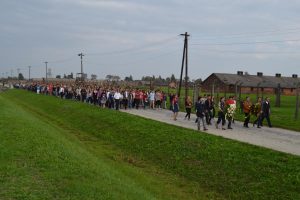 Often, these advertisements can attract a certain type of tourist that may not understand the significance of the site and is not able to treat it with respect. For example, in Birkenau, when visiting the building that housed the latrines, litter had been thoughtlessly tossed into the toilets where many prisoners would have worked. When passing the carriage that took people directly to the gas chambers, a tourist was stood smiling with his thumbs up posing for a photograph.
Often, these advertisements can attract a certain type of tourist that may not understand the significance of the site and is not able to treat it with respect. For example, in Birkenau, when visiting the building that housed the latrines, litter had been thoughtlessly tossed into the toilets where many prisoners would have worked. When passing the carriage that took people directly to the gas chambers, a tourist was stood smiling with his thumbs up posing for a photograph.
Although it is a positive sign that visitor numbers to Auschwitz I and Birkenau are increasing – after all there are fewer and fewer survivors around to tell their story first-hand – tourism is having a noticeably detrimental effect on the authenticity of the sites due to vandalism such as graffiti and theft.
It is easy to become immune to the graffiti covered walls that have become so commonplace in many European cities. However, it is shocking and disappointing to see the scribbling of names and dates on the walls of many of the blocks in Birkenau from tourists wanting to leave proof of their visit. It seems that not even Auschwitz-Birkenau, a memorial site deserving the highest level of respect, can escape graffiti.
Another sad consequence that the Memorial and Museum occasionally has to contend with is theft. Some visitors not only want to leave a trace of themselves behind, but want to take a memento home with them too. In 2015, two British schoolboys were caught stealing buttons, spoons and a comb from the camp, posing the question: do younger visitors have the maturity to understand the level of respect that concentration camps deserve? Other items that have been stolen by tourists include barbed wire and screws from the railway tracks in Birkenau.
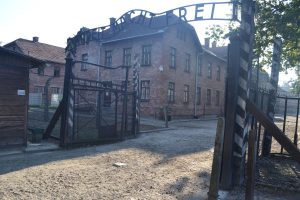
But perhaps the most infamous case of theft occurred in 2009 when the ‘Arbeit Macht Frei’ sign was stolen from the gate at Auschwitz, provoking a nationwide police hunt, protests and international upset. The sign was found three days later in northern Poland, cut up into three pieces. In 2010, a former neo-Nazi from Sweden was charged with masterminding the theft. A replica sign now sits in its place.
Although there is an age limit that prevents people aged under 14 entering the camps, parents are often seen with toddlers and young children in pushchairs and child safety harnesses. It could be said that children are too young to comprehend the significance of where they are and are too young to be respectful of their surroundings. Often, it seems inappropriate to hear children laughing and playing in a place of mourning and reflection. On the other hand, concentration camps were never built for living, therefore, bringing children into the camps almost brings innocence and joy into a place that was only ever intended for the dead.
 It is important that visitors are aware of their surroundings and are respectful in a place that has witnessed so much suffering. However people choose to reflect in Auschwitz-Birkenau, it is important to note that the Holocaust took place merely 71 years ago and genocide is still happening today. It is not enough to go and reflect personally on lessons from the past, we must share these lessons with others to create a future that is free from hatred, persecution and genocide.
It is important that visitors are aware of their surroundings and are respectful in a place that has witnessed so much suffering. However people choose to reflect in Auschwitz-Birkenau, it is important to note that the Holocaust took place merely 71 years ago and genocide is still happening today. It is not enough to go and reflect personally on lessons from the past, we must share these lessons with others to create a future that is free from hatred, persecution and genocide.
For more information:
- Find out more about our theme vision for HMD 2017 here.
- Read the first staff blog about the loss of Jewish life and culture in Poland here.
The HMDT blog highlights topics relevant to our work in Holocaust and genocide education and commemoration. We hear from a variety of guest contributors who provide a range of personal perspectives on issues relevant to them, including those who have experienced state-sponsored persecution and genocide. The views expressed are those of the author and do not necessarily represent the views of HMDT.